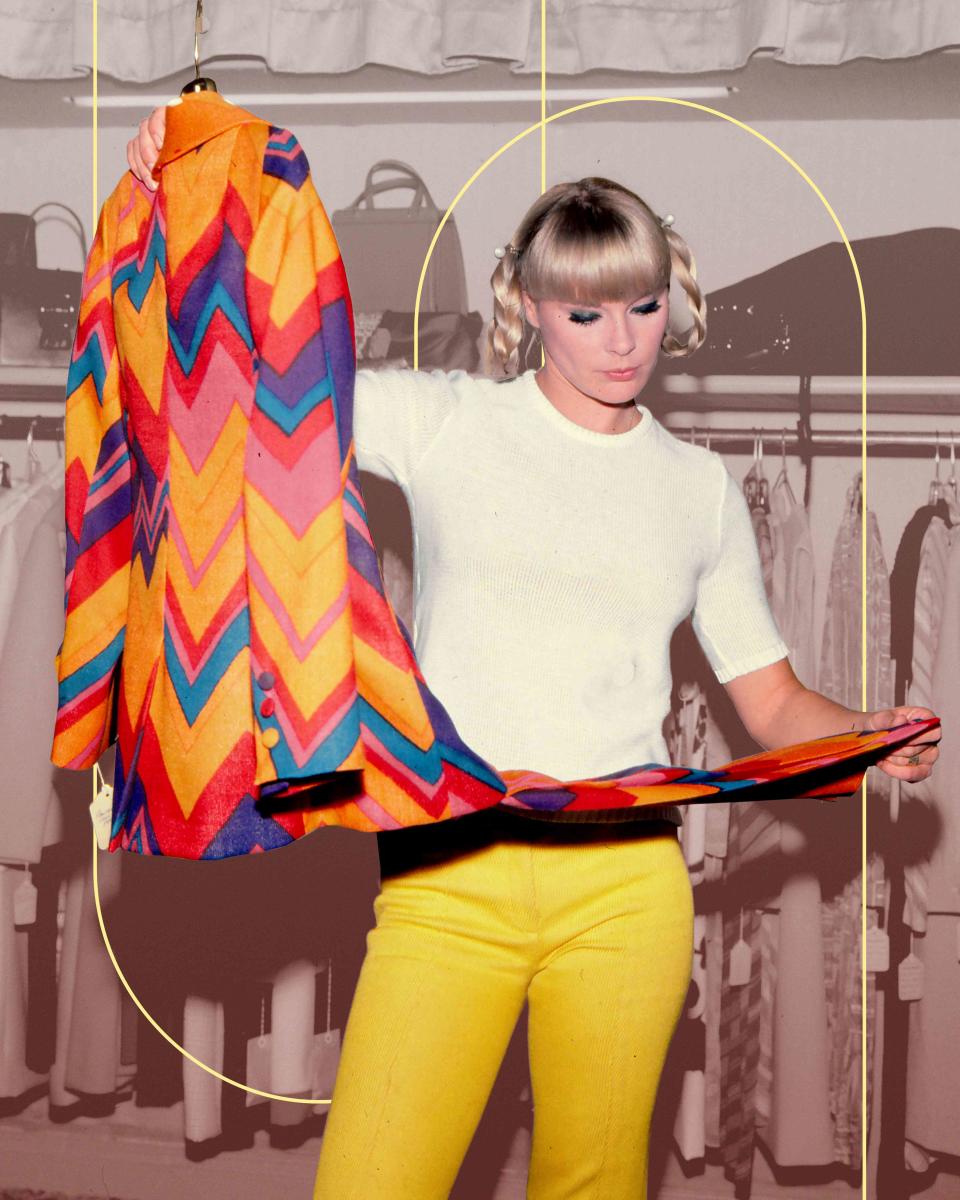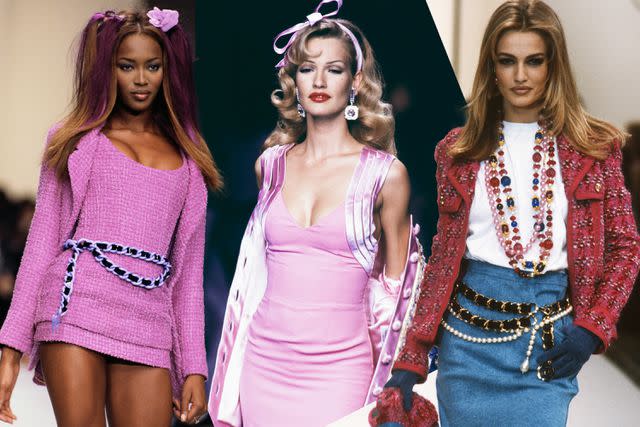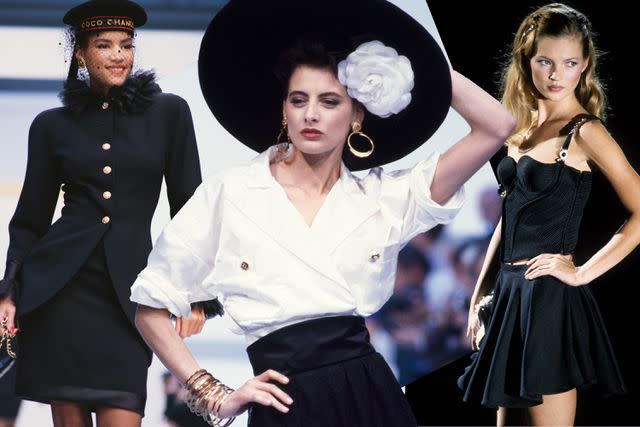Your “No BS” Guide to Fashion Resale from Two Serious Vintage Experts
- Oops!Something went wrong.Please try again later.
- Oops!Something went wrong.Please try again later.
Remember when vintage shopping didn’t feel like a contact sport?

Getty Images/ InStyle
“Even up until 2015, Jean Paul Gaultier shirts at regular thrift stores were $10,” says Johnny Valencia, owner of Pechuga Vintage. “That same shirt now is $400 to $500.”
In 2021, 42% of millennial and Gen Z respondents of a global survey said they were likely to shop secondhand for items — up 10% from Gen X participants and even more so from the boomer generation. You don’t need to have passed college economics (I didn’t) to understand how demand drives prices, and that same year, Statista estimated the global market value of secondhand clothing was 96 billion U.S. dollars.
Valencia, who co-hosts the fashion podcast The Fitting Room with Brooke and Pechuga, has a theory that the pandemic gave people more time to research their interests. Now everyone wants to know more about what they’re wearing.
The vintage owner specializes in Vivienne Westwood, who he previously worked for, and is known for filling his shop with rare corsets. Earlier this year he outfitted Westwood’s granddaughter Cora Corré (who he also counts as a friend) in one of the dame’s creations for the Green Carpet Fashion Awards.

Getty Images/ InStyle
“All of a sudden, there’s this need for everybody to have a story attached to the pieces that they wear in their collection,” Valencia says. “I’ve been doing this for almost five years, and it [wasn’t] until recently that my clients asked me, they’re like, ‘oh, can you share a bit of information on when this piece comes from or who made it [or] why it was made?’”
And the competition for thrifted and vintage pieces isn’t going to go away. Quartz reported that secondhand clothing is expected to make up 10% of all clothing sales in the U.S. by the end of 2025, according to estimates by eMarketer and Insider Intelligence. “It can be pretty addictive,” says Liisa Jokinen, co-founder of Gem, about secondhand shopping.
Often called “Vintage Google,” Gem indexes popular resale sites like The RealReal and Poshmark as well as more than 1,000 independent vintage stores, with new shops added to the app weekly. “We did a big trend forecasting roundup with people who work with vintage and secondhand and some vintage lovers. One trend that almost all of them mentioned was personal style,” says Jokinen. “More than any specific decades, designers, or items, people are gravitating more and more toward expressing their individuality and their personality with clothes.”
So shoppers on the hunt for a particular item need either more money or more wits. We can’t get you more money (sorry), but for our New & Next issue, we tapped Valencia and Jokinen to share their most practical tips.
From the thrift store to the auction house, here’s what they have to say about finding your vintage white whale.

Getty Images/ InStyle
Check Yourself
The number-one rule of vintage shopping is knowing your measurements — in inches and in centimeters.
Like society’s understanding of what constitutes a date, clothing sizes have fluctuated dramatically over the decades. This phenomenon is even more greatly felt if you’re browsing dresses from say, an Italian brand, where a size four could be a size 40 or a 44 or a secret third thing.
“The measurements are effectively the only way you can be sure the item fits you,” Jokinen says. “I have my own measurements on my phone so I have them with me whenever, wherever I go.”
If you’re shopping in person, consider bringing a cloth measuring tape, too, just to make sure you don’t take a piece home only to be disappointed, especially since some thrift and consignment stores don’t allow try-ons for luxury items.
Get Creative With Your Search Terms
From coastal grandma to balletcore and even gorpcore, Jokinen recommends trying funny words and adjectives when searching online (just like leaning into niche TikTok trends to see what comes up).
Another trick is to search construction details from the trend or decade you are looking to shop. For example, search “vintage knit mesh” on eBay to find crochet dresses and “vintage hook and eye” to find authentic 1930s to 1940s corsetry.
Check the Price
When you are considering making a purchase, try searching your find in Gem to do price comparisons on your phone first.
“Maybe sometimes you think that, ‘Oh my god, this is a real gem, a rare item, and it's okay to pay $500 for this thing,’ but maybe it isn’t that rare,” warns Jokinen. “If you get excited about a find, maybe sit with it at least for a minute and see if there are similar listings [and] how much they are priced so that you are not overpaying.”
Don't Overconsume
It’s easy to get wrapped up in the thrill of the chase, but you can overconsume secondhand clothing just like you can with new clothing if you are not mindful, Jokinen warns. Ask yourself how often you’ll wear it and if it’s really “you.” You don’t need to buy something just because you’ll never find another one like it. Unless it’s the only one on the market — like some of the couture pieces that Valencia sources — you probably will. And even then, don’t let ego swipe your card. “There is such a thing as fair market pricing,” Valencia points out.
Lurk the Seller's Instagram
If there aren’t reviews available (not all platforms have them), check if they have an Instagram account. If it’s active and “they’re going strong” posting and interacting, says Jokinen, that’s a good sign that they’re willing to help out customers.
“They want to help you to find the perfect piece, so don’t hesitate to reach out to sellers,” says Jokinen. “Ask [for] more photos, ask for details, [and] ask for measurements because then it's better that both of you are happy in the end [than if both of you] are unhappy.”
Find a Good Repair Person
It goes without saying that tailoring is a big part of the resale game, but fixing little tears and imperfections can also make an old piece look like new. “Like my accountant told me one time,” says Valencia, “You wouldn't take your computer to the mechanic." So, you’ll need a good resource for repairs.
Maintenance cost is a standard part of shopping vintage — “You have to go to the cobbler to take care of your really expensive shoes. You have to go to a proper tailor.” — but the right specialist can also bring a rare find back to life.
“I was able to source two different types of corset makers in L.A. … to restore our Westwood corsets,” says Valencia. “’Cause if it still has the most basic skeletal structure, you can salvage something, typically.”
Depending on what’s in your vintage collection, take some time to find the right experts for you. That could mean a skilled tailor if you’re really into suiting, or a leather specialist if you’re more of a bag connoisseur.
Try an Auction
Finally, for serious shoppers only — consider auction houses. Specifically Christie’s and Kerry Taylor Auctions.
Valencia, whose TikToks of bidding on online auctions I watch like horse races, says there is no greater bargain than that which you find at an auction house. The competitor pool isn’t so broad, and sometimes “people forget or don’t wake up in time,” says Valencia. “So the deals — I tell my clients all the time — the deals and the grails are out there.”
But those with commitment issues need not apply.
“You have to keep a calendar, you have to set alarms, you have to pull all-nighters, and you have to have the money,” he says. If you win and you don't pay, “you are absolutely going to get blacklisted. It’s not something that they take lightly because you're messing up with their livelihood.”
Know What You're Looking For
The best advice Valencia can give to anybody: Study. The reseller says vintage hunting has an “archeological” aspect to it. Knowing the history of brands, styles, and eras you love can help you sort through clues about a piece’s provenance — and give you hints as to whether the pricing is fair. Case in point, a recent treasure he found while traveling.
Attracted by a “nicely arranged blanket” at an open-air souk, Valencia picked up a pair of Christian Dior glasses with the lenses popped out. “It says made in Austria, and based on that information, I'm like, ‘oh, okay, cool.’ So I know that this was made before the ’70s [and] before they moved their production from Italy to Austria,” he explains.
Set Some Alerts
Whether you’re on the hunt for a pair of Tabi boots or a Stella McCartney–-era Chloé jacket, getting a highly sought-after vintage item often comes down to good timing. That’s why Jokinen added “new item alerts” to the Gem app and “daily emails for new listings that match your searches,” which can be especially helpful when finding your vintage white whale.
So, set those eBay alerts for keywords, save your favorite The RealReal searches, and turn on notifications for your favorite Instagram sellers. You never know what you might find.
For more InStyle news, make sure to sign up for our newsletter!
Read the original article on InStyle.

